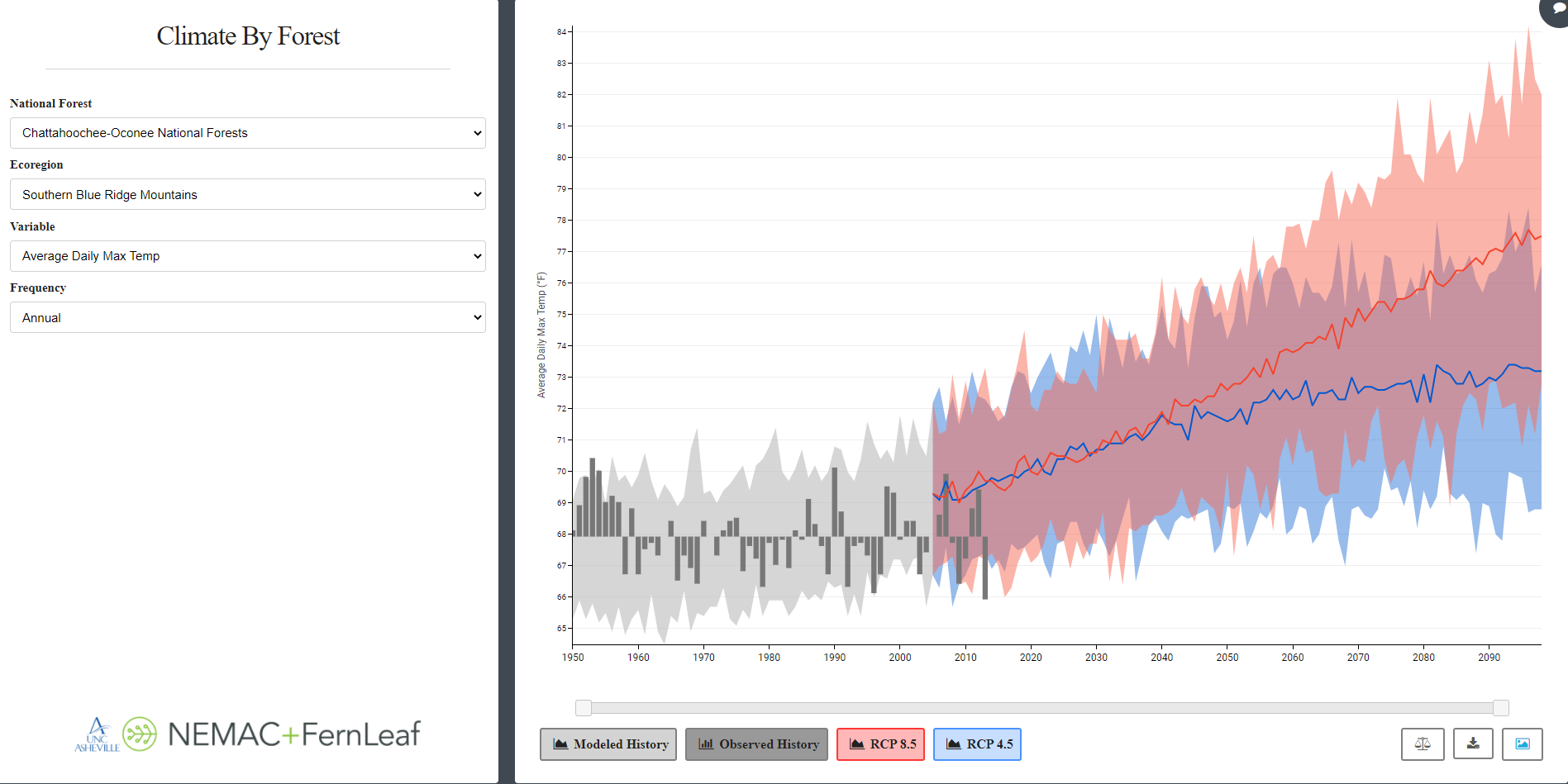Customizing an open-source tool
After the 2012 National Forest System Planning Rule directed the USDA Forest Service to begin considering climate change in their land management plans, Forest Service personnel turned to NOAA’s Climate Explorer tool to get projections of future climate conditions. This tool from the U.S. Climate Resilience Toolkit provides climate projections for every county in the contiguous United States.
Working with developers of the open-source Climate Explorer, Forest Service employees from the Forest Service Southern Region, Southern Research Station, and the USDA Southeast Climate Hub requested a version of the tool that would let them access data for specific geographical units. The derivative tool, capable of accessing projection data by ecoregion within National Forest System lands, was dubbed Climate by Forest.
Using this first version of Climate by Forest, forest planners could obtain climate change graphs and data files with just a few clicks. However, they still had to perform statistical analyses on the data to test whether projected changes would lead to a significant departure from historical conditions. This second step required days to weeks of a climate specialist’s time to find, process, and reformat a large number of data files. Forest Service personnel, led by then regional climate change coordinator Emrys Treasure, came up with a way to produce summary statistics (including significance and uncertainty tables) for each national forest unit’s ecoregions. Developers incorporated the relevant statistical methods into the tool, enabling managers for every forest unit in the lower 48 states to access projections and the relevant statistical documentation for their plans from Climate by Forest in a matter of minutes.

The image shows a screenshot of the Climate by Forest tool. The graph shows historical modeled and observed (grey) and projected future (under a higher emissions scenario (red) and a lower emissions scenario (blue)) annual average daily maximum temperature in the Chattahoochee-Oconee National Forests in the Southern Blue Ridge Mountains ecoregion.
Savings on Development
Leveraging an existing tool rather than developing a new one resulted in significant savings of time and money for the Forest Service. Developing the original specifications for Climate Explorer took hundreds of hours of deliberation among a dozen subject-matter experts and interagency climate modelers. Once the specifications were spelled out, coding the solution required 10 months of work from a senior-level engineer and two other developers. Based on this example, had the Forest Service started from scratch, it would have taken nearly a year to develop Climate by Forest and cost around $350K.
Savings on Operations
Climate by Forest’s new capabilities also reduced operational costs for the Forest Service. For each new Biennial Monitoring and Evaluation Report produced using Climate by Forest, a specialist saves around 80 hours of searching, finding, organizing, evaluating, and summarizing climate information into an understandable and defensible format. At a savings of $5K for each report, the six forest units that have used Climate by Forest for their reports to date have accumulated $30K in savings. This figure will continue increasing as additional units use the tool to support their land management planning effort. If all 112 Forest Service administrative units use the tool, the total savings would exceed a half-million dollars.
As Climate by Forest is aligned with the Climate Explorer’s code base and hosted on the same servers, the Forest Service is also saving an estimated $10K per year on hosting, maintenance, and support of the tool.
Building on Regional Climate Center Capabilities
The Applied Climate Information System (ACIS) is an additional resource that underpins both the Climate Explorer and Climate by Forest. NOAA’s Regional Climate Centers developed this system of data and web services to facilitate access to specific climate information. Anyone with the requisite coding skills can access climate data or build automated tools to share these data. Without the availability of this federally funded resource, both Climate Explorer and Climate by Forest would need to process and serve the entire set of projection data themselves. Using ACIS saved each agency around $200K.
Return on Investment
All told, the Forest Service’s $35K investment in Climate by Forest has netted them total benefits worth $600K in the first two years of the tool’s existence. And NOAA is now encouraging others to consider if customizing open-source tools could meet their climate information needs. As one example, transportation and water managers may want to customize existing tools to help them access climate information by watershed.
The Forest Service’s willingness to customize an existing federal tool is helping forest units obtain the information they need to help them adapt to new climate conditions on our national lands. This example of interagency cooperation and re-use of open-source climate tools shows how federal agencies work together to save taxpayers money as they ramp up their response to the climate crisis. Ultimately, leveraging the best climate change science available in an efficient and consistent way increases both capacity and understanding towards the Forest Service mission to sustain the health, diversity, and productivity of the Nation’s forests and grasslands to meet the needs of present and future generations.









